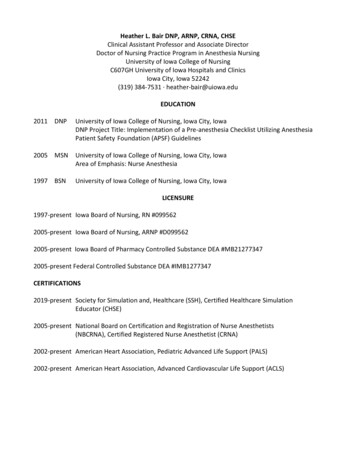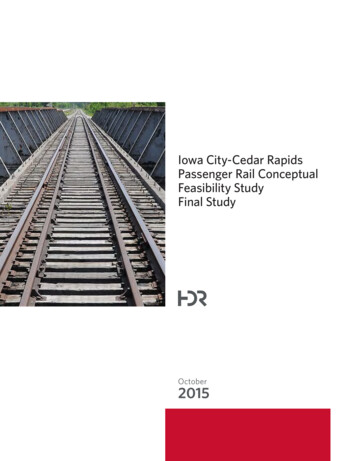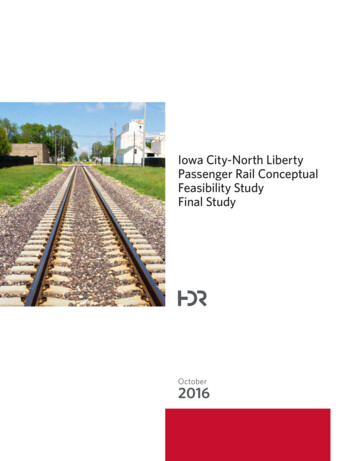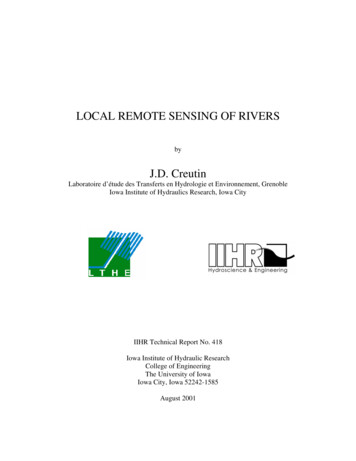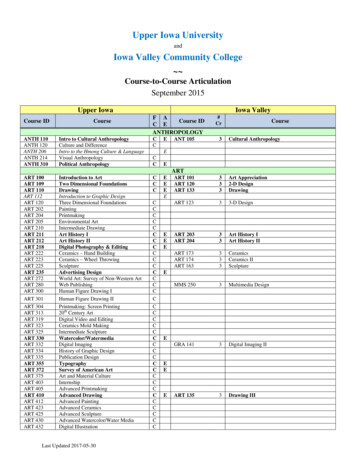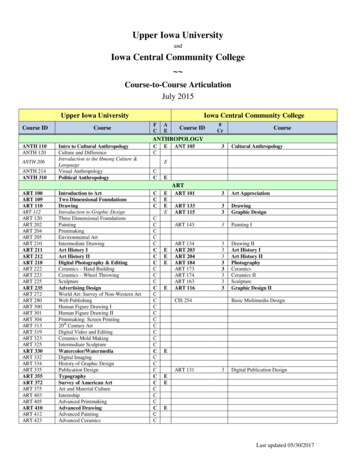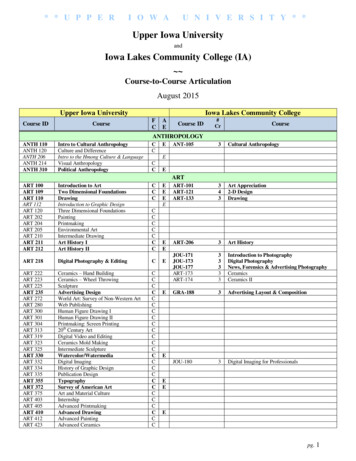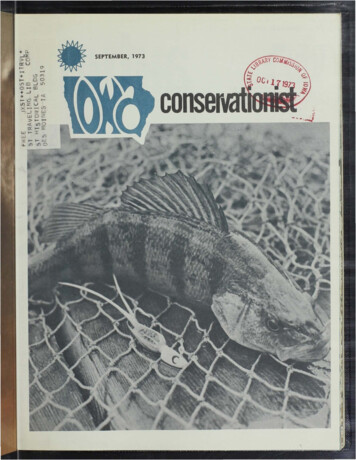
Transcription
· .J SEPTEMBER, 1973 0o::v- -1--0". .
SEPTEMBER, 1973onconseR O GER SPA R K SE D ITO RWA Y NE L O NN I NGJ ER R Y L.E O N AR O PH O T O GRA P HERP H OTOGRA PHERBy Roger Spark PageCONTENTS2 Autumn Gold1 Keeping Tabs on Bobwhite9 Why Iowa Has Good Hunting10 1973 Waterfowl14 Warden's Diary14 Shooting Sports Are Safe1 5 Classroom Corner16 1973-74 Hunting andTrapping Season and LimitsFred A . Priewert , Direc t orCOMMISSIONERSLES LICKLIDER, Chotrmon - Che ro keeTHOMA S A . BATES Be llev ueJ IM D. B IXLER - Council BluffsJO HN G LINK Burlmg to nHERBERT T REED - Wm te rsetJOHN C THOM PSON - Fo res t C1tyCA ROLYN LUMBARD, Des MomesIowa ConservationistVol 32September, 1973No. 9Published monthly by the Iowa Conservation CommiSSion . State Off1ce BU1Id1ng ,300 4th Street. Des Mo1nes. Iowa 50319Address all ma11 (subscnpt1ons, change ofaddress. Form 3579 manuscnpts. ma11items) to the above addressSubscnpt1on pnce one year at 1 00two years at 2 00four years at 3 50Second class postage pa1d at Des Mo1nes.Iowa No R1ghts Reserved)( (.I., ., . /I '\w , 4JJtl' ,\, , . ,,."' ), . if,.;.'tl (t, 'I,,J ,'I\'.-·!lU!lJT:f\1!'1
IOWA CONSERVATIONISTThere's magic In gold leavesfluttering against the clear,autumn blue. The dry, cool breezesignals ducks to fly, leaves to fall,and football stadiums to fill onSaturday afternoons. In Iowa'snatural lakes country, in-theknow anglers go "prospecting forgold" as yellow perch tie on thefall feedbag.Around Spirit Lake, West Okobuji and most other natural lakesin the northern part of the state,perch rank high on the angler's(and gourmet's) list of desirablefish. The most consistent perchfishing comes during the fall,after many rods have been stored.Fishing improves following thefirst frost and as the water coolsit remains good, well after Ice up.The best bet for big perch, footlong fish weighing up to a po , ,is Spirit Lake. Most fish ·East, and West Oko ·rununder 10 inchoften provide3faster action. Use that boat during the day and fish deep wateroff rock piles or around deepweedbeds. In late September andOctober, evening perch fishingcan be fantastic Fish move to theshoreline and anglers castingfrom docks, around stream outs, and off rocky points, cleanup.Best tackle is a lightweight orultralight rod with a reel holdingline light enough to handle tiny- ·-.- .,., .-'. . v. '.,, -, . .,., ."
,. \ . - .' .:. #. .'i .1 .J '. . .,.1, . .,. I ,",JI /,'. ., , l ,'.'IJA foil morning on West Okoboji . It,J-· .·' , J.I ,. ' . .I,;v , ., I 'Photo by Jerry Leonard I J . . ;' · '·"Photo by Ken FormanekI L ./. ,Ao . I . · ,.'' '., II '. ;I .' 't. . " · '., I'/ . . ,. /I j.,I'.; .",. 'lt'. ' . I 1
IOWA CONSERVATIONIST5 . Ready for the pan .'.) I\I IItlures. Some argue that ultralightgear may cause the loss of alarger fish - a walleye or northern pike which may occasionallytake the smaller baits - but theperch purist goes light.Small leadheads, one sixteenthounce and smaller are good alongwith spinners, spoons and miniature diving plugs. Worms andsmall minnows are top baits. Ifthe fishing is slow during midday, try a combination. Attach aminnow or a small piece of nightcrawler to a leadhead with themckle removed. Fish it slowly it'll pay off. Drifting a tiny icefishing lure baited with a piece ofworm will take fall perch, or justtrolling a spinner I minnow orspinner/ worm combination willscore.Flyrodders working the rockypoints or wading the shorelineshallows often take a 25 fish limiton a fall evening. Perch are schoolfish and the action usually comesin bunches, particularly in theevening hours. Try any colorfulstreamer or large wet fly.Although they're small, perchare plentiful, fat, and they filletout well. Fried to a golden brownthe choice pieces taste similar to,and maybe a bit sweeter thanthose of their famous cousin, thewalleye.If that thought can't competewith a football game, nothingcan.1;:(Fall pe rch calls for worm clothingPhoto by Jerry Leonard
lI(I
IOWA CONSERVATIONIST By Charles C. SchwartzWildlife BiologistOne of the many problems associated with wildlife researchand management involves keeping an account of the number ofanimals with which we are dealing. Knowing the answer to thequestion "how many" is one ofthe prerequisites to any researchor management program.The bobwhite quail, one ofIowa's important game species, isone of the many game animals onwhich the Iowa ConservationCommission annually keeps tabs.How do we keep track of bobw hite populations in Iow a? Basically, there are th ree major surveys conducted annually to estimate changes in quail numbers.These are: (1) a late- springw histling cock survey, (2) anAugust production survey and(3) a bird-dog census on a studyarea.The late-spring survey, referr ed to as a July whistling-cocksurvey, is used to estimate thepotential spring breeding population. It is also used to determinedistribution of quail populationsin Iow a. The technique relies onone of the basic behaviorial char-acteristlcs of the bobwhite; themale's whistle to attract a mate.Throughout southern Iowa, thereare designated survey routeswhere wildlife biologists and conservation officers count the totalnumber of different calling malequail they hear. This number isthen used as an index to estimatethe spring breeding bird densityand changes in spring quail numbers. This is reflected by annualchanges in the yearly index. Reliable indices to quail abundancecan be obtained without knowing,in absolute terms, the exact number of quail in Iowa, and can beobtained with less effort than isrequired for a complete census.The second survey is a production estimation conducted in August. This survey, like the Julywhistling-cock survey, relies onone of the many behavioral characteristics of game birds. Duringlate summer, e a r 1y morningheavy dews are common. Quail,like pheasants and rabbits, do notlike to stay in wet cover so theymove to open areas to dry offOne place where they are commonly seen is along roadsidenghts-of-way. Realizing this fact,the Conservation Commissionconducts an annual roadside survey of small game in mid-August.As with the July whistle countstandard routes are locatedthroughout Iowa's quail range.Starting at sunrise, trained personnel drive these routes andrecord all game sighted, including the bobwhite. Informationfrom this survey is then used todetermine the reproductive success for that year and to predictthe coming fall population.If we look at the Au ust survey information that has beencollected for the last ten yearsand compare this to fall huntingsuccess certain trends become obvious. When the number of quailsighted on the August roadsidesurvey increases, there Is a goodchance that the fall harvest willalso increase, and vtsa-versa. Ifwe apply certain statistical tests,which are used by biologists tohelp ex plain the relationship between two factors, we see that 90percent of the change in our quailharvest is explained by thechange in our August survey. Thesame statistics used to determinehow closely related our summersurvey is to our fall harvest canalso tell us how often we can expect to be correct in our predictions. It turns out that the probability of our harvest predictions being correct is also about90 percent. In other words, wecan successfully predict the quailharvest (which is related to yoursuccess) nine out of ten times.Why not ten out of ten? There areseveral factors which our surveyIS unable to predict. As you know,good quail hunting is related notonly to good covey numbers, butalso to weather, how well thecorn and soybean harvest is alongand many other factors. Duringoddball years like 1972-73 we areunable to predict the extent ofcrop harvest and weather. Eventhough bird numbers may havebeen adequate for a good quailseason, old man weather did notcooperate.Our third survey, the bird dogsurvey, consists of systematicallysearching 4,700 acres of privateland in southern Iowa each falland spring. This survey is usuallyconducted just prior to quail season and just after severe winterweather ends. During this quailcount, biologists aided by pointing dogs systematically cover thestudy area and count all the quailthey find. This information isused to monitor long and shorttermed changes in population ona discrete unit of land Such datacan be used to study the effectsof winter weather on quail mortality and abundance. In addition,long term effects on quail numbers, from changing land usepractices, like increased grazingor land clearing, can be documented.As you can see, the Conservation Commission is expendingmanpower and effort each year tokeep track of our quail populations. Hope f u 11 y, informationgathered from these surveys willgive us msight and a basic understanding of population changesfor one of Iowa's finest gamebirds.i:.r7
."""' . '\.;,. t · · ·.,- a. "' ' .l ·-
IOWACONSERVATIONIST9,Its. By Rex EmersonLow Enforcement SupervisorHunting is one of the greatestsports in Iowa. It is indeed a thrillto see a good bird dog pointing acovey of quail, or to hear thesquawk of a big rooster pheasantas he becomes airborne. Perhapsyou enjoy seeing waterfowl beingdecoyed in to your spread on themarsh, or it may be the white tailof a deer disappearing into thewoods, or a little beagle dog chasing a cottontail rabbit that makesyour spine tingle.Whatever your favorite gameanimal might be, did you everwonder how we can have suchgood hunting in Iowa since thestate has become more populated,and with a substantial increase inthe number of hunters.Everyone knows it takes food,water, and cover for wildlife.Without these factors wildlifecould not survive. However, thereis one more very important factor, and that is protection; protection during the closed seasonwhen the wildlife are raisingtheir young; protection for endangered species; enforcement oflimits so there is enough game togo around for all those who liketo hunt, but with enough left overfor next year's breeding stock.Your Conservation Officer isdoing that job for you by enforcing the state's fish and game laws.This very energetic and dedicatedman receives his salary from thesale of licenses rather than fromtax funds. He may be in charge ofone or two counties, or in somecases three counties, so give himyour cooperation and assistance.He is working for you. The hoursare many, and the pay is not toobad unless you fi u re it by thehour, but due to his genuine interest in promoting conservationhe enjoys every minute of hisday.Let's take a look at just onetypical fall day in this officer'slife. It starts early in the morningwhen he might be walking asmall creek looking for illegaltraps and checking animal tracksto get an idea of wildlife populations in the area. Sounds like abit of a biologist.A gun shot over the next hillarouses his curiosity and needs tobe checked out. It might be anillegal hunter. So through thewoods and over the hill. He's asprinter, too, you know.There are licenses to be checkedduring the day, and will includevisiting with the hunters. Maybehe can help them to be moresuccessful with their sport. Orperhaps a fanner is having someproblems with hunters that didn'task permission to hunt. He's adiplomat, too, you know.Some of the hunters will beviolating the law, and If they areapprehended, some time will bespent in court making out informations and presenting his case.Almost a lawyer, too, you know.A call comes in on his radiothat a license depositor has somequestions and would like for theofficer to stop by. While in townhe better get a radio programtaped for next Saturday. He's agood public relations man, youknow.After supper is a hunter safetyclass for a group of Boy Scouts.These classes require a minimumof four hours instruction. Oh, yes,he's a teacher, too!It's been a long day and sohome to bed. Then the telephonerings. A car has hit and killed adeer, and the dead animal mustbe disposed of. So back to work.Each day is different, butusually quite as busy. However,it is not at all unusual for someone to say to him, " Well, thehunting season opens tomorrow.I suppose you will have to go towork now." If the officer hadn'tbeen working days and also somenights there wouldn't be anyhunting season to open.Yes, game cover is very important, but as long as we have people, the important thing to wildlife abundance is protection. TheConservation Officer is not justa game warden ; he is "Mr. Conservation."
' ,- . , ,"wJ. r,.v«t;·; ,.l. .A,. . · - r,:-1 ,, . ,' .(\.'oft !',,.II.-,I .,,.,,,"' I 'ttlr / ,'I, J. .' . '\. .).' ,J . ·it. t .
IOWA CONSERVATIONIST '0 0 FALL FLIGHT ORECASTRichard A. BishopWaterfowl Research Biologist The 1973 fall flight of ducksfrom the Canadian Prairies downthe Mississippi Flyway is estimated to be about 30 percentlower than in 1972. This is theculmination of a series of eventswhich has led to a bleak fallflight forecast. The scene was setin the spring of 1972 when goodwaterfowl habitat conditionsfailed to produce ducklings andresulted in a below normal hatch.The absence of young ducks inthe 1972 fall migration allowedhunter harvest to cut into the1973 breeding population. Thisoccurred even with a 11 percentdecline in the 1972 MississippiFlyway duck harvest.A mild dry winter in Canada,both Dakotas, Montana and northwest Minnesota, coupled withless than substantial sprin Q: rains,caused a 42 percent declme inpothole numbers from 1972 (down41 percent from the 1955-72 average). Breeding surveys indicatedmany non-breeding birds and allsigns hinted towards poor productwn. These surveys showed a decrease of 15 percent in the mal-lard breeding population from1972 and an overall decrease of15 percent for all ducks.Late season rains which occurred in June and July createdslightly better than average waterconditions, however, m ost of thisrain fell north of the betterbreeding habitat. Much of Manitoba and both Dakota's still remain dry. The rains came too lateto significantly affect early production but should stimulatesome late nesting attempts andensure survival of the broods produced. Brood survival is very important and can make or breakthe annual production forecast.Regulations proposed for the1973 hunting season are curtailedsomewhat from 1972. The cutbackis mainly in the length of the season and a shght reduction in thedaily mallard bag for states acceptmg the point system. TheIowa Conservation Commissionchose to hunt under the pointsystem option with the followingguidelines. 45 day season undera 100 point system, shootmg hoursfrom sunnse to sunset, a split sea-son which will open October 6and run through October 10, reopening October 20 and continuing through November 28, theMississippi River proper will beclosed to the shooting of canvasbacks and redheads. Point allocations are as follows:100 PointsRedhead, Canvasback (excepton the Mississippi River the season on canvasback and redheadswill be closed) .90 PointsFemale Mallard, Wood Duck,Hooded Merganser.25 PointsDrake Mallards, Pintails, BlackDucks and all others not specified.15 PointsBlue - winged Teal, Greenwinged Teal, Scaup, Widgeon.Shoveller, Gadwall, Sea Ducks,Mergansers (except hooded)Th1s presents the hunter withthe potential daily bag limit offrom 1 to 7 ducks depending onthe species and the order taken.11
12Prlbalwotwpe:waDaIastiotioarrcaltiauadaIof! \b ttyWEthlhaalrhath,W1te ofCOJ COJthlM;In(brlIo1nosic
IOWA CONSERVATIONISTProviding a redhead or canvasback was not shot first, hunterswould have a minimum bag oftwo ducks regardless of species.These regulations do not appear to be curtailed as severely aswaterfowl populations indicate.Data strongly suggest that as longas hunters abide by the regulations there are built-in restrictions in the point system andample recreational opportunitycan be offered without substantial increases in the harvest. Evaluation of past-hunting seasondata indicates that the magnitudeof harvest projected from the1973 regulations will result in areduction in the 1974 mallardbreeding population in the vicinity of one million birds. However,we feel this is acceptable due tothe lack of prospective breedinghabitat in 1974 and the fact thatalmost any season allowed wouldhave resulted in a reduction inthe 1974 breeding population.When water returns to the prairies, moderate seasons will allowthe re-population of this habitat.One additional fact is the increased number of ducks breeding outside what we call the"major duck factory," in areassuch as Iowa, Wisconsin, Michigan, Ontario and the far north.(While working on geese innorthern Manitoba this spring Iobserved almost twice the number of mallard pairs compared tolast year.) I believe productionfrom the forested region andnorthward to above the tree linewill be more significant than inpast years.The success of Iowa hunters isnot always dependent on overallfall flight forecast. We can experience good hunting even in yearsof poor production if migrationconditions are just right. Theprospects for hunting in Iowa willdepend on weather and migrationconditions. One bright aspect isthe big increase in local ducks.May surveys showed approximately a 30 percent increase inbreeding teal and mallards inIowa and recent observations innorthern Iowa leaves the impression of a good hatch of ducks.Many mallard broods were seenin flooded agricultural fields suggesting above normal reproduction on private lands. This shouldincrease the chances for a successful early hunting season.The goose picture is quite adifferent story. To briefly sum upthis situation, we experienced anearly spring break up in the Arctic. This encompassed the majority of the breeding range of bothblue and snow geese and Canadageese. Mild weather during thenesting and early brood rearmgperiod created ideal conditionsfor good success. Fair weathercoupled with a larger number ofbreeding females should produceone of the best fall flights ofgeese in recent years.When large numbers of youngare present, the midwest statesusually have high harvest rates.This is the result of the vulnerability of young inexperiencedgeese and the fact that they cannot withstand long flights without replenishing their energy reserves. This causes the birds topause and feed frequently whichcreates ideal hunting conditionsfor this season. Goose huntingshould be much Improved over1972.The goose season will openOctober 1 and run through November 9 for Canada geese only.Blue and snow goose hunting willbe allowed from October 1 thruDecember 9. The daily bag limitwill be five geese of which nomore than one can be a Canadagoose and two white- frontedgeese. The possession limit of fivegeese may not include more thantwo Canada geese and two whitefronted geese. Shooting hours arefrom sunrise to sunset.Please note that our attemptsto re-establish the giant Canadagoose in northern Iowa have beenhighly successful. This year withgood local goose production weestimate the hatch of Iowa Canada geese to be between 700-1,000birds. We will continue to buildthis flock for the benefit of theresource and the Iowa public. i:J:'13
14The fir s t of a series of excerpts takenfr om an officer's notebook.By Rex EmersonLaw Enforcement SupervisorI IThis is starting the third daythat I have been sitting on thisriver bank near a fish trap. Itrained a little bit last night. Asheet of plastic sure came inhandy to keep dry Can't build afire; the smoke would be seen bythe violator. Canned heat wasmade for this job. Beans and soupcan be heated without tell-talesmoke. Nothing worse than coldbeans for two or three days. Hada few little catnaps during thenight using a boat cushion for apillow. Didn't know whiskerscould itch so much' 7·45 a.m. Acar is commg across the field.Looks like a little action is aboutto start. A gooseberry bush ISsure thorny to take cover under,but the river can be seen fromhere.lreBet you thought hunting is ahazardous sport. Act u a ll y , itranks 16th on the list of hazardous sports, accordmg to a majormsurance companyIn order of risk, they are:1. Football2. Winter Sports3 Baseball4 Swimming5. Basketball6. Skating7. Accidents in the country or atthe beach8. Bicycling9. Accidents at parks, picnicsand outings10. Golf11. Horseback Ridmg12. Boating and Canoeing13. Gymnastics14. F ishing15 Accidents at churches,theaters and concerts16. Hu7:50 a.m. The car stopped realclose by. A man in overalls, blueshirt, and a tan cap got out. Hewalked the remaining thirty feetto the river bank and lookedaround for what seemed an eternity. Satisfied that all was clearhe got in his boat and wentstraight out to the fish trap.l lw orked on squirrel huntingpatrol today. The early seasonsquirrel hunters have problemsWith all the leaves still on thetrees. One squirrel hunter toldme he didn't know whether toshoot at squirrels or mosquitoes.It seemed like there wasn't muchdifference in the size!8:05 a .m . He dropped a bigiron hook attached to a rope overthe side and hooked the tail ropeof the trap. The trap was soon inthe boat, the lid taken off and fishbeing dumped on the floor of theold John boat. A noisy blue jayhad just discovered me. The noiseof that old bird was put to my advantage, as it covered the click ofmy camera. I was too close to useit before. As the trap slid backinto the water I quickly changedlocations to a big oak tree locatedbetween the car and the violator.On his way to the car with hissack of fish he was surpnsed tofind himself within three feet ofa game warden. It was too late torun, but I'm sure he wished hecould just sink into the groundA citation was Issued for hiscourt appearance the next day.The sack of eight catfish will beheld by me as evidence. Therewere some real nice fish in thesack and they got a litte heavy asI earned them dow n the nverabout a quarter mile to where myboat was hid The fish trap waspulled out, and it, too, will beheld as evidence. The fish w ill berough-dressed and frozen. Theywill have to be held until afterthe court heari ng and t he date ofappeal, w hich w ill be another 20days After that the county homewtll get them.It's tlme to go home and getthese whiskers off, and have a hotmeal; m that order.Most of the good hunters areout in the timber about daylight.It is difficult to check his licensebecause he will sit down on theground and lean back against atree to quietly wait for a squirrelto show himself. He thinks It realfunny If the warden walks pastw1thout seeing him. If the hunting 1s good, the shots will soonpinpomt the hunter's location.One hunter had a dog thatwould tree squirrels and thenbark at them. He was easy tofind, and he was a little embarrassed when asked for h1s hunting license, because he had forgot to get one. "I'll buy one justas soon as I get back to town," hesaid. I told him, "Fine, I hope youdo, because that is where the Fishand Game D i v is ion gets themoney to furnish the protectionfor w ildlife, but you must have alicense before you go hunting andbe able to produce it upon requestof an officer or land-owner . Ihave no chmce but to issue acitation ordering you to appear incourt next Monday at 9:00 a.m."The r est of the day was spentabout the same There wer e twomore hunters Without a license,and one with an assembled gunin his car All will have their dayin courtWent home at 5.00 p.m andcleaned up. Had a 6·00 p.m. supper mee tmg with the Lion's Club,and gave a short talk abou t t hehunt mg seasons and limits."1::r
IOWA CONSERVATIONIST'I7 3.'0'3 1/2.'------lii.-.J jJmg50nmsthePI.ACE SUPPORT STICKSHERE AFTER ASSEMBLY., --old IsICl:r-1e' 2'm'ht.1sehe;a 2'2"9' .- sll 112'I'II-fSIDE(2R D1)u./- -a·1.'0'.::I6'2'l L L. 2 -BACKF IIO' TIt. -- sl-. "4'-v --!,.I .L2'.J., .4 112'reiealastnt· ·- rl .,:· j l.Jton: at:' ntwolSe,runlaYINOTE .ALL SLOTS lSI ARE 2' LONGBy Curt Poll'rllAdm1n1stratorConservatiOn Educat1on&' IjThe huntmg season Is upon usand the seasons are changing.This is the time of the year to renew our acquaintance with thenatural beauty of fall. Iowa outdoors offers a fascinating opportunity to appreciate the unfoldingdramas of the hunt, changing seasons, migrations, and winter preparatwn by many of Iowa's resident animals and birds.For those who hunt it is thetime to become familiar withhunting seasons, bag and possession limits, species Identificationand, most certamly safety whilehunting. Did you know that theIowa Conservation Commissionhas an excellent hunter safetyeducation program? In case yourhunting involves the use of boats,did you know that the Conservation Commission has a boatingsafety coordinator and is in theprocess of developmg a watersafety education program?Keeping busy during the winter months is good for all creatures, inc 1 u ding man. Thereshould be things that we can doduring the winter months thatcould be used later on in thespring or summer. The HennepinCounty Park Reserve District atMinneapolis, Minnesota, offeredthis project for classroom work.Classroom Corner has modifiedthe design somewhat for ease ofassembling. Have you ever builta bird house from cardboard? Itcan be done.Cut your heavy cardboard according to the dimensions shownon the plan Waterproof thepieces with shellac, varnish, orpaint. Assemble the birdhouseand place a stick across the topand bottom of the house to giveit support. The hole in the frontshould be 1" for wrens or 1 2" forbluebirds.15
.-·' (en. .If Ic . t-\IIi;XI).lOoi\y Possession1973 - 1974 HUI-ITII'IG - TRAPPII'IG SEASOI-IS Al-10BogLIMITSlimitlimitShooting HoursOotes6 o.rn - 6 p m .SeosonSept. \ - Feb . 28RABBITtCottontoil & jock)SQUIRREL(fox and gray) DEER (bowlSplit Season DEER (shotgun)All zonesCANADA GEESEGEESE (other spectes)Sept \ - Dec 3 \Oct \ 3 - Nov. 25Dee 8- \6Dec \ - 5Oct \ -Nov 9Oct \ -Dec 9J Oct 6- \0\ Oct. 20 -Nov. 28Sept. \ -Nov. 4Sept. \ -Nov. 4Sept 22- Nov. 25DUCKScooTRAILS tSoro & Virginia)SNIPE Nvilson's-JocklwooDcocK RACCOONZone \ -N of U S 20zone 2-rernotnder stateNoneYz hr. before sunriseYz hr. after sunsetSunnse to sunsetSunnse to sunsetSunrise to sunsetSunrise to sunsetSunrise to sunsetSunrise to sunsetSunrise to sunset8 om -4:30p.m.NoneNone8 om - 4:30p.m.8 am - 4:30p.m.8 am - 4 :30 p.m.8 a m - 4:30 p.m.None\06\2'''2'\CheCk regulottonsPotnt system1530252585\6\0NoneNone8NoneNone\64\2Oct \ 3 - Feb . \ 5Oct 27 Feb. \ 523Oct 27- Jon. 3\84Oct 20 -Nov. 25NoneQUAILNoneNov\0Jon6GROUSE truffedlNov . \0- Jon. 6NoneNonePHEASANTNoneJune \5 - Nov. 30PARTRIDGE (Hungonon)NoneNoneNone" WOODCHUCKSept. \ - Feb. \ 5None" FOX (hunting)Conttnuous open(red and gray)seasoncoYOTE ,;unte.s possessing bOth hotgun and bOW dee I "'"' maY toke onlY one de '. ,-he"' .-o'"'"' open ot 6 om on opening doY and wo\1 do.e ot midnight on c\D'in9 doYl 973 TRAPPtt-tG SEASOt-tSMINK.MUSKRi'1"FOX (Red and G Y) ----BEl'-VER--6 o m Novembe I 0 to m dnight oecembe 3 I , I 97 36 o m Octo\ "' 27 to midnight J onuorl 3 I , I 97 6 o m. Novemb ' I 0 to midnight AP" I I S, I 97 RP.CCOON.OPOSSUM.Sl"RIPEOBJ'.OGERSKUNK,and WEP.SELSPOTfEO SKUNK6 o.m(CovetOctCotl,27 to midn ght Feb I 5, I 97 OTfER---- No open ,ea,onCOYOl"EContonuou open '"'"N01"E' WoW sets o.O pe,.,.ated onty ho"' 6 ·"'· N · lOtb to .,.idnigbt Oe · 31 .tooes not opp\y t o beover)
Our third survey, the bird dog survey, consists of systematically searching 4,700 acres of private land in southern Iowa each fall and spring. This survey is usually conducted just prior to quail sea son and just after severe winter weather ends. During this quail count, biologists aided by point ing dogs systematically cover the


